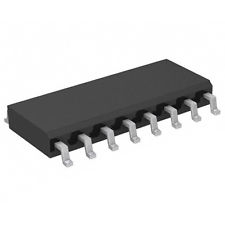...
This documents highlights the steps taken to rectify this. The detail of the steps taken are now in subsections, allowing the reader to go into detail if required.
...
The object of this exercise is to see if by redefining the design on a small PCB, with the same footprint (SMD SO16) of the existing decode chip, a faster decode could be achieved by
- Using high speed NAND gates, to see if then if that was successful
- Then try using Use a decode chip from the same family.
- Using the knowledge gained, add the circuit on the card to add the more components to make a high speed 7413974xx139 card.
The Z88 only uses one half of the dual functionality of the full chip.
...
Using 5 NAND Gates to prove that there is a hardware problem was very useful, but for a production run using a single 2-to-4 Line Decoder chip to replace them is the next step.
This circuit could now be bread-boarded and tested outside the Z88 card case again.
The four signal and power lines can be seen connecting the card to the breadboard.
Results
The Games play played without crashing. The PCB could now be designed.
Printed Circuit Board
2-to-4 Line Decoder or SMD SO16 - DIL Convertor
Provisional Layout
Turbo Card to be produced
It has been proved that the decode chip in the Z88 Flash/RAM card is too slow. Existing users who wish to use OZ v4.6 (or later) will need their cards modified with the chip being replaced with this card.
Full
...
74xx139 Version Build Concept
Tiny url http://tinyurl.com/zf9haly
A new opportunity or a waste of time?
The decoder chip above works. It changes the timing from 10 to 3nS and replaces 1/4 of the 74139 for in the Z88 design. Is there a demand for a 74xx139 replacement card?
For the full version, adding 2 OR, dual logic gates to the outputs enables adds the /CE signal to the design. The challenge is to
- fit 6 chips into a 16 pin DIL footprint
- establish whether there is a demand
SMD or DIL Footprint?
| 16 pin DIL | 16 pin SO 16 |
|---|---|
Using the PCB above with pins to connect the PCB piggybacked below both footprints may be accommodated.
Build on a 16 pin DIL footprint
This should be possible, 3 chips on each side of the PCB with 2 rows of 8 pins on either side. The PCB will be designed to see if this is possible on a 2 layer board.
Demand or not?
Once the PCB design has been completed, it can be costed and this concept can be floated.
A decision may be made then whether to proceed with manufacture the PCB or not. It could be used in legacy equipment to see if it improved the performance. There could also be different options.
- card only
- card and components (to build)
- fully built
It will definitely not be able to compete on price, as it will cost more than 10p.


